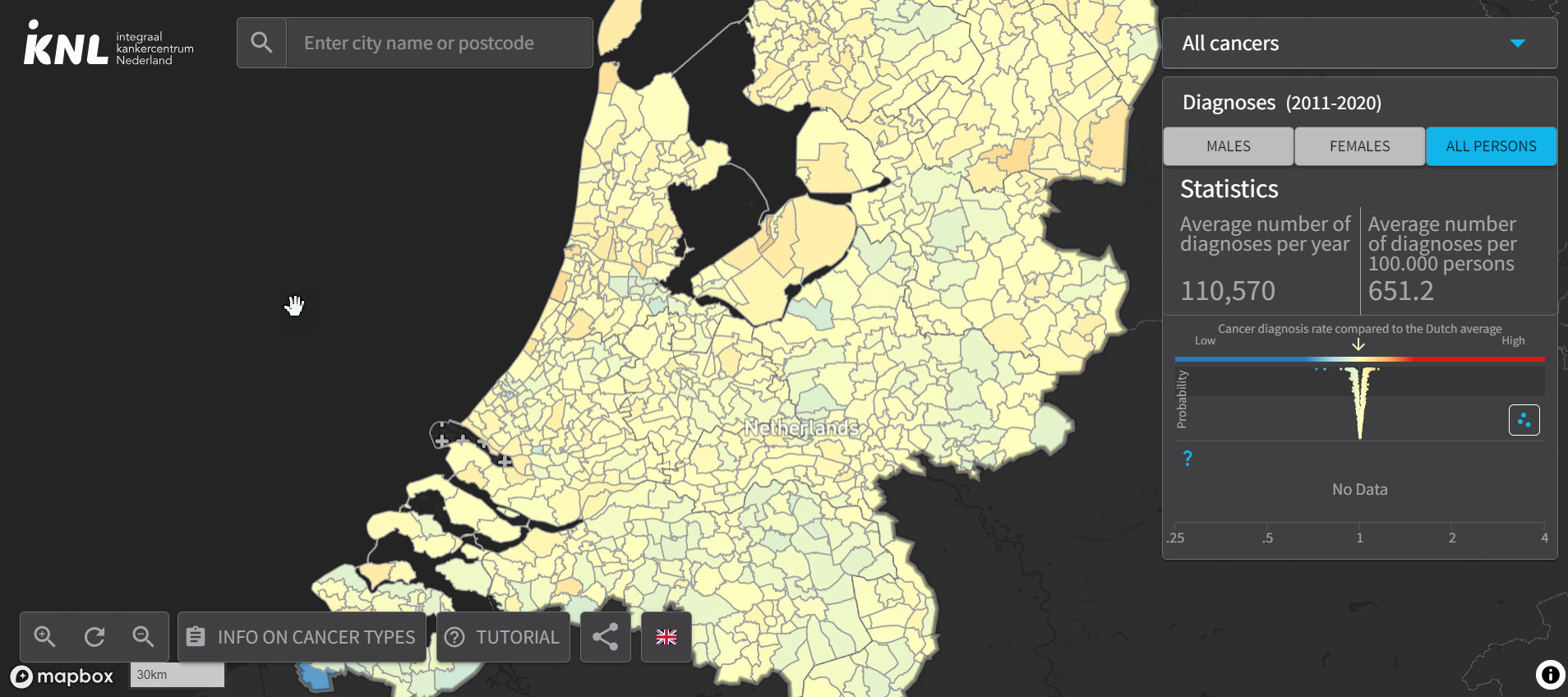
English translation Dutch Cancer Atlas available
With the launch of the Dutch Cancer Atlas by the Netherlands Comprehensive Cancer Organisation (IKNL) in January 2023, anyone can gain insight into the regional impact of cancer in the Netherlands. Now, the Dutch Cancer Atlas is also available in English; you can switch to English by clicking on the ‘change language’ button (with the flag) within the atlas itself. The interactive online atlas shows geographical patterns in cancer diagnoses, based on where people lived when they were diagnosed. IKNL analyzed these patterns for the 24 most common cancers in the Netherlands and for all of those cancers combined. Geographical variation can be observed for certain cancers, while for others, there is little to no variation. For all cancers combined, there is minimal geographical variation in the Netherlands.
Direct access to the Dutch Cancer Atlas
(switch languages by clicking on the ‘change language’ button with the flag at the bottom of the screen)
The Dutch Cancer Atlas indicates per small region, based on the first three digits of their postcode, whether the diagnosis rate of a particular cancer type is higher, equal to or lower than the Dutch average rate. Where possible, additional information per cancer type is provided in the atlas under the 'info on cancer types' button about the observed variation and the potential causes of that variation. The insights from the Dutch Cancer Atlas, for example for lung cancer, skin cancer and cervical cancer serve as a foundation for regional prevention policy measures which help to reduce the impact of cancer.
Local figures do not reflect individual risk
Project leader and researcher Dr. Jaike Praagman emphasizes: 'The Dutch Cancer Atlas shows in which regions the diagnosis rate is higher or lower than we expect if we take into account how many people live in a region, how old they are and whether they are men or women. Users of the atlas can filter the information by tumor type and by men or women. However, it is important to realize that the insights from the Dutch Cancer Atlas do not reflect an individual’s risk of cancer, but are averages for each specific area.'
What can you do yourself to reduce the risk of cancer?
Prof. dr. Valery Lemmens: 'Regardless of what happens in our environment, it is important to know that we can also take action ourselves to reduce the risk of cancer. Everyone knows that not smoking or quitting smoking helps to promote health and lowers the risk of various types of cancer. But in the Trend Report 'Cancer in the Netherlands 2032, trends and forecasts' (in Dutch) published by IKNL at the end of 2022, we show that the most common type of cancer in the Netherlands, skin cancer, is on the rise. It is therefore crucial to protect ourselves adequately from the sun. In addition, you can reduce your risk of cancer by maintaining a healthy weight, limiting alcohol intake and exercising regularly. Eating a diet rich in fruit and vegetables and reducing processed meat and red meat (from cattle, pigs, sheep and goats - ed) can also lower the risk of cancer. Finally, consider participating in population studies for colon, breast and cervical cancer when you receive a call to participate.'
Creation
The Dutch Cancer Atlas from IKNL is based on the Australian Cancer Atlas, which was created by a team from Cancer Council Queensland (CCQ), the Queensland University of Technology (QUT) and FrontierSI. The estimated figures shown in the Dutch Cancer Atlas were calculated based on cancer data from the Netherlands Cancer Registry (NCR) and population data from Statistics Netherlands (CBS).IKNL used the same advanced statistical modeling techniques as were used and developed for the Australian Cancer Atlas and the visualization of the atlas was done by ViseR from QUT. All accompanying texts in the atlas were checked with content-expert scientific researchers and, if necessary, with healthcare professionals and employees of the Municipal Health Services (GGD).
Follow-up
Lemmens: 'The Dutch Cancer Atlas can be expanded over time with additional information and can be updated as soon as sufficient new data become available, which allows us to see changes in variation. But our first focus is to gain experience with the available data. In this project we have learned a lot from our Australian colleagues about the statistical models used for analyzing the collected NCR data and presenting this information in interactive maps. We think that the Dutch Cancer Atlas is a valuable resource that can benefit everyone. We are pleased that the Dutch Cancer Society (KWF) is planning on making targeted regional investments in response to the Dutch Cancer Atlas. The atlas also provides additional input for GGD and municipalities, based on data, to shape regional prevention policies and reduce the inequalities in cancer risk across the Netherlands. Together we can ultimately ensure that far fewer people are affected by cancer.'
More information
Everyone can visit the Dutch Cancer Atlas and find more information on it via www.iknl.nl/kankeratlas. This page also contains more background information, a video with an explanation and answers to frequently asked questions (in Dutch).

